The corrent one AT Collection of american model trains in HO scale was formed since 1998, when there was the transition from European-produced rolling stock (especially that offered by Rivarossi in the old and inadequate 1:82 reproduction scale) to that produced by manufacturers in the United States. In this section, are listed all models of freight cars (and cabooses) that form the rosters for the projects Conrail Early Years 1976-1978 e Pennsylvania Railroad Pittsburgh Division 1957-1963, both based on layouts and dioramas. The long list here below (scroll to full viewing) is made up of information and images. When is available the single review card for a given HO scale replica, this is marked with a special label/button (only in ITALIAN LANGUAGE).
FREIGHT CARS and CABOOSES Freight cars brief history. A very essential part of rail transport around the world is obviously the ROLLING STOCK, the hauled component formed of freight cars with all its variants specialized for every type of load to be transported on global rail network and the coaches for transporting passengers (not reviewed here), including the variants for baggage and express mail. | |
BOXCAR The boxcar is the most common type of freight car used since the beginning of the american railroads. Thousands and thousands of boxcar were built by many industries to put in service on the tracks the better way for carrying every kind of goods. There are many types of boxcar, built using wood or metal frame, with different lenght and capacity. The classification of those freight cars type has been done following the main characteristics and taking names and different classes, within each railway companies.  X72 class boxcar Conrail #269338.  PS-1 50' boxcar Boston & Maine #863. 40' X26 class single sheathed USRA wood boxcar PRR #564543 (built 1919)  The PRR X26 class of wood boxcar was derivated by a model designed by USRA (United States Railroad Administration) since 1910. The "Pennsy" acquires its first variant of this boxcar beetwen 1919-1920, following the X25 class that was the first series of this boxcar type.  Tichy Train Group RTR Series PRR X26 class boxcar. 40' Mather wood boxcar IN #2023 (built 1948) From the 1920s through the 1950s, when freight car manufacturing and leasing were largely the province of big corporations like General American and American Car & Foundry, the Mather Company remained relatively small, privately owned and presided over by its namesake, Alonzo C. Mather. Using proven designs and off-the-shelf components, his company cranked out utilitarian cars using a minimum of specialized components or machine tools. The hand-built cars were cheap to build and maintain, so the company flourished because its cars could be leased at very competitive rates. Because railroads couldn't afford new cars from the major builders, the Mather Company's shops built or rebuilt many box cars for lease during the Depression. These cars remained in service through World War II and, updated with AB air brakes and more modern trucks, many of them lasted through the 1950's and into the 1960's, by which time the Mather Company had been acquired by the North American Car Company. With their distinctive Mather construction and sheet metal Mather Patent roofs, they could be seen all across the North American railroad network.  Walthers Proto Mather wood boxcar. 40' X26c class USRA steel rebuilt boxcar PRR #105808/#105530 (built 1919)  By the beginning of WWII, the majority of the classic USRA double-sheathed box cars and their clones were rebuilt with steel sides. More rebuilds followed in the late 1940s and early 1950s. By late 1948, close 14.000 of the original 24.500 USRA double-sheathed cars had been rebuilt with quite a degree of variation including the end, door and underframe. These steel side rebuilds were far more popular than their single-sheathed counterparts.  Atlas Master Line PRR X26c class boxcar. 40' X29 class 50-ton all steel boxcar PRR #100467/#100554/#101801 (built 1934)  In 1923, the ARA (American Railway Association) proposed a standard design all-steel box car for the american railroads. The largest fleet of these freight cars, was undoubtedly purchased by the Pennsylvania Railroad. PRR assigned to this car the designation X29 class (sub-classes were developed). In 1957 remain in service over 30,000 cars, used throughout the huge PRR network, used for the transport of any goods not perishable.  Red Caboose PRR X29 class boxcar.  Red Caboose PRR X29 class boxcar. 40' modified AAR boxcar ERIE #80268 (built 1941)  The 1944 AAR boxcar is an evolution of 1937 design. The primary variations are the updated ends, known as "dreadnaught ends". Other changes have involved many exterior details as ladders, the panel roof and about only some units and the new doors (Superior model door and Youngstown door with different sizes). ERIE Railroad sold many hundreds of this boxcar type, put in service to carry not perishables goods.  Intermountain Railway Co. AAR boxcar. 40' PS-1 single door 8' Youngstown boxcar N&W #44263 (built 1951) 40' PS-1 boxcar with 7' 5-Panel Superior Door MONON #859 (built 1953)   Pullman-Standard built thousands of ARA and AAR boxcars through the mid-1940s, but in 1947 P.S. began producing its PS-1 line of boxcars. Basically, these new boxcars were further developments of 1944 AAR design, built in 40- and 50-foot lenghts. The PS-1 boxcar proved immensely popular with over 75.000 cars produced for 79 railroads and private owners.  Kadee PS-1 boxcar.  Kadee PS-1 boxcar. M-53 wagon-top boxcar B&O #380934-#1924 R.E.A. (built 1937)  The design of the Baltimore & Ohio Railroad wagontop boxcars was one of the true innovations in boxcar production during the entire history of american railroading. The B&O created express boxcars from the M-53 class wagontop to meet the increased demand for mail storage and Railway Express Agency movements surrounding World War II. The production of new C-16 class beginning in 1937. The first 25 M-53s were re-equipped with steam and signal lines and additional vertical and lateral grab irons on the ends. From 1937 the B&O also constructed 2,000 additional Wagontops, classed M-53, numbers 380000-381999. In 1953 an additional 1,000 cars were built as class M-53A and numbered 385000-385999. Following, a total of 125 were converted from 1941 to 1945.  Fox Valley Models M53 Wagontop boxcar. 50' X44 class post-war single door boxcar PRR #604419 (built 1951)  At the end of Second World War, railroads ordered large numbers of 50' AAR boxcars with a standard design that was first widely used in the late 1940s. This design was based on the original 1937 AAR design but was modified in the post-war era to include: improved dreadnaught end and diagonal panel roofs with standard or overhanging design. These 50' boxcars were a common sight on american railroads well into the 1970s and 1980s. Pennsylvania Railroad called this 50' boxcar X44 class.  Atlas Master Line PRR X44 class boxcar. 50' automobile "double door" boxcar NYC #64474/#64184 (built 1941)  Originating in the 1890, 50' boxcars were adapted to the needs of the automotive industry early in the 20th century with double side doors for easy loading at docks and ramps. In 1942, the Association of American Railroads (AAR) adopted a new standard all-steel design that included the latest pressed steel ends and doors.  Walthers Proto Automobile boxcar. 50' X58 class boxcar PRR #113347 (built 1966) 50' X58 class boxcar PC #265753 (built 1974) 50' X58 class boxcar CR #229723 (built 1976) 50' X58 class boxcar LV #8210 (built 1965)     The X58 Class boxcar was one of the Pennsylvania's largest classes of boxcars. At the Penn Central merger, just over 2,000 X58 and their subclasses were in service. Many X58 survived onto Conrail with the original heritage colors (CR patched) and/or repainted, as some units in former Lehigh Valley white livery.  Tangent Scale Model X58 class boxcars.  Tangent Scale Model X58 class boxcar.  Tangent Scale Model X58 class boxcar. 50' G.A. RBL Sill 1 10'6" Offset door narrow rods boxcar N&W #693577 (built 1963)  In 1962 General American Corp. began building its most popular insulated boxcar models, a refinement of their proven 1950s design. One of the most important developments for this type of car was the all-welded body structure, where only the roof was bolted on after insulation. Other features included 20-inch cushioned underframes and a variety of load restraining devices for customer specifications.  Moloco RBL Sill boxcar. 50' PS-1 boxcar B&M #77064 (built 1956 - repaint 1977)  Pullman Standard built the longer version of its 40' PS-1 boxcar from 1952. The greatest variation was in the size and style of doors used. Later, Pullman Standard also offered 60′ boxcars – also with the PS-1 designation.  Kadee PS-1 boxcar. 50' PCF RBL Plt-B 10-0 offset door boxcar EL (NITX) #60019 (built 1962)  In 1959, Pacific Car & Foundry (PC&F) partnered with Southern Pacific to design and develop a new series of boxcars, the "Insulated" boxcars, codenamed RBL. They began with side-door boxcars, in a B-plate position, for carrying canned goods and groceries, needed for most of SP's and its subsidiary SSW's service areas. Variants with different doors were designed in late 1962. The RBL boxcars were used by numerous railroads throughout the United States. 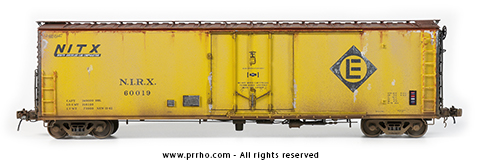 Moloco Trains PCF RBL boxcar. 50' SIECO boxcar B&M #78239 (built 1973) 50' SIECO boxcar N&W #57829 (built 1975)   The 1970s saw a shift from general purpose 40-foot (12.7 m) to 50-foot (15.2 m) outside pole boxcars. Incentive per day (IPD) regulations made it very attractive for railroads to acquire large fleets of boxcars. In addition to larger companies such as Pullman Standard and American Car & Foundry (ACF), Southern Iron & Equipment Co. (SIECO) also entered the 50-foot (15.2 m) boxcar business. SIECO cars were recognizable by the "gap" between the roof and the sides of the car. Produced between 1971 and 1990, many examples ran on eastern railroad lines well into the 2000s.  Athearn Genesis SIECO boxcar.  Athearn Genesis SIECO boxcar. 50' PC&F SS boxcar with 14' Plug Door SP/UP #850110 (built 1974)   Bunkerless box/reefer car (built by Pacific Car & Foundry in many hundreds units) with or without ventilating devices and with or without device for attaching portable heaters. Construction with insulation in side ends, floor and roof to meet maximum UA factor requirement of 250 BTU/F/Hour for this type 50 foot cars. Equipped with adjustable loading or stowing device.  Athearn Genesis PC&F boxcar. 50' FMC-5077 single-door boxcar RB #17721/#18407 (built 1975)  The boxcar with the single-sliding door configuration is one of the best known and used widely by many different railroads. These cars were produced using the Gunderson metal works which FMC had acquired in 1965. In late 1975, FMC began producing a 5,077-cubic-foot Plate B boxcar for IPD and Railbox services. Railbox Company (reporting marks ABOX, RBOX, TBOX, FBOX) was founded in 1974, created to address a boxcar shortage in the United States in the 1970s. It is a subsidiary of the Chicago-based TTX Company.  Atlas Master Line FMC boxcar. 50' N.A.C.C. plug-door boxcar CNJ #41030 (built 1964) 50' N.A.C.C. plug-door boxcar QOCX #330 (built 1966)   The 50' NACC boxcar was designed and built by the North American Car Corporation (NACC) in the early 1960s. The car was an insulated boxcar (equipped with a plug-door) used to carry various commodities that are temperature sensitive. The plug door offers better sealing of the car to maintain temperature and better protection from weather, theft, and other possible damages. Several railroads rostered this car with most of them either purchased by or leased to private shippers (as QOCX to transport foods and cereals). 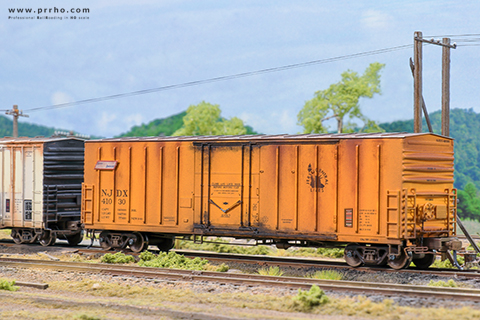 Athearn Genesis NACC boxcar.  Athearn Genesis NACC boxcar. 50' X72 class Evans boxcar PC #269320 (built 1972)  The X72 class is a general purpose boxcar that can be found in nearly every service, making it a very common piece of equipment throughout North America. Some cars are equipped with DF Belt Loaders for assisting in loading and unloading of special equipment, while other cars are equipped with Dual Air Paks for in-shipment shock control of goods and pallets. These specially equipped cars are in assigned service to specific industries for specific loading. Between 1972 and 1973, Penn Central received the first of over 1065 boxcars in the X72/X72A fleet from US Railroad Manufacturing's (Evans) Blue Island, Illinois plant. These cars would eventually find their way to Conrail in 1976, retaining their PC numbering series while getting CR reporting marks. Some cars received full repaints, while others received just patch jobs.  Rapido Trains Evans X72 class boxcar. 60' X77 class 70-ton Berwick 7440 Appliance boxcar PC #278129 (built 1974)  This Hi-cube car was built and delivered in 1973 by the Berwick Forge and Fabricating Corporation in the former AC&F Berwick, Pennsylvania plant. Penn Central was the largest buyer and took delivery of 130 of them (equipment series 278045 - 278174). The Illinois Central Gulf, Norfolk & Western and Rock Island also acquired a handfull each.  Exactrail X77 class boxcar. Greenville Steel Car Company 6000cf 60’ Double Plug Door boxcar NYC #53115 (built 1964)  The expansion of boxcar building in the 1960s was fueled by demand for specialized car types. One key type was the 60-foot (18-meter) boxcar designed to accommodate dense auto components such as engines, bumpers, axles, and glass. Greenville Steel Car was an innovator in this type of boxcar, first introducing these 60-foot (18-meter) boxcars in 1963. Greenville's boxcars had a distinctive "fishbelly" design and Youngstown Steel Door Company double center doors with a 16-foot (4.8-meter) opening.  Tangent Scale Models Greenville 6000cf boxcar. 60' Thrall 5880cf Double Plug Door boxcar N&W-601171 (built 1969)  Thrall Car Manufacturing Incorporated, based in Chicago Heights, Illinois, was a new boxcar manufacturer in the 1960s with a solid offering of boxcars for hauling specials auto parts. Thrall built its first 60-foot boxcars in 1963 and used welded construction. In 1969, Thrall released a modernized 5,880-cubic-foot model (Plate C 5880cf) to service Ford, featuring double-entry center doors, the distinctive "double-weld" sidewall construction, and "X-Panel" roofs. Initially, twelve railroads purchased these cars, and these workhorses remained in service well into the 2000s.  Tangent Scale Models Thrall 5880cf boxcar. 86' Greenville Double Plug Door boxcar CR #238097 (built 1976)  During the 1960s, the most radical freight car designs employed the extreme height clearances offered by "Plate-F" car designs. In 1964, no car type articulated this extreme more than the 86-foot, purpose-built “Auto Parts” boxcars. These large boxcars became fixtures on the rails all over North American mainlines, added in heavy freight trains to deliver components vital to the productivity of auto plants. Several car builders offered 86’ auto parts boxcars and the most prolific builder of the double plug door design was Greenville Steel Car Company of Greenville, PA. More than 4.400 of these biggest cars were acquired by most major railroads and they were assigned to pools where multiple railroad’s cars served a specific shipper or shippers. Original utilization of these cars was for Ford, Pontiac, and Chrysler, as well as deliveries from 3rd party parts suppliers to the auto plants. Greenville’s boxcars 1964-1978 production was the longest run for this car type, with many still in service today. 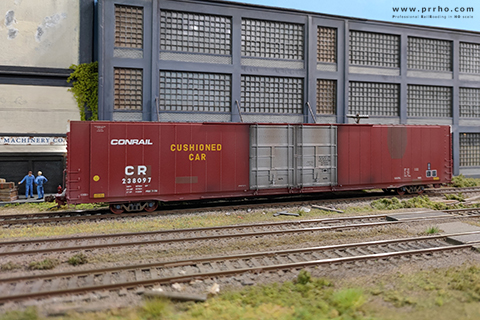 Tangent Scale Models Greenville H.C. boxcar. GONDOLA CAR The gondola car in North American railroad terminology, is an open roof rail vehicle used to transport bulk materials, such as metal scrap, stone, lumber, or others type heavy loads. Due to their low side walls, the gondolas are also suitable for transporting high density loads such as steel plates or coils, or bulky items such as prefabricated sections of track. During many years an enormous quantity of types about gondolas were built, follows the needs of each individual railroads. 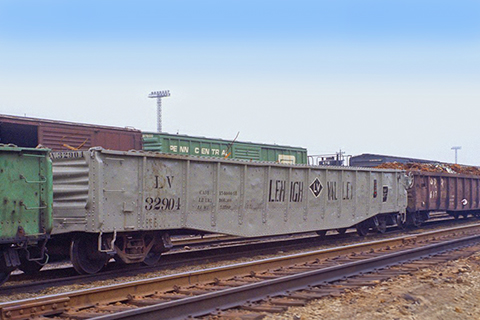 70-ton riveted gondola car Lehigh Valley #32904. 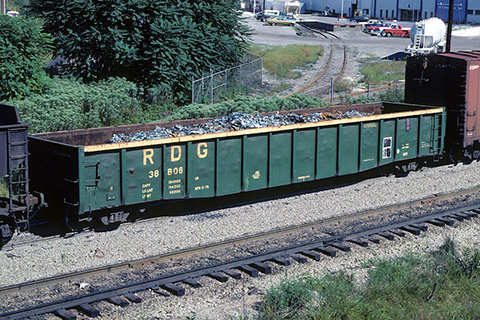 GH class gondola car Reading #38806. GS class gondola car PRR #290158 (built 1906)  By 1949, the all-steel GS class was the largest group of gondolas on the Pennsy network and the fourth largest group of any class of road freight cars. In that year, 14,485 of the original 32,700 cars were in service, dropping to 300 by 1955. The total number of GS gondolas was greater than the entire fleet of railroads such as the Pere Marquette, Western Maryland, New Haven, Delaware & Hudson, and CNJ/CRP. The oldest gondolas of this series dated back to the early 1900s. The main versions of the GS class remaining in the late 1940s were the GS subclasses (also a subclass), GSD and GSH. The GS subclass constituted the vast majority. They had flat bottoms, solid ends, and the folding drawbar carriers applied in the 1920s and 1930s. The GSH subclass numbered 893 cars and received angle braces under the sides and at the top or bulbous corners, but their picket posts had been removed when they were modified in 1945. They were also flat-bottomed cars with solid fronts. GSD featured steel sides, steel floor, fixed ends, straight sill, and fishbelly underframe. The GS class served as the Pennsy's equivalent to a pickup truck, with its 50-ton capacity. The gondola cars were excellent for scrap metal, steel billet and sheet, steel sections, tires, pipe, limestone, as well as other in-process and finished industrial products. 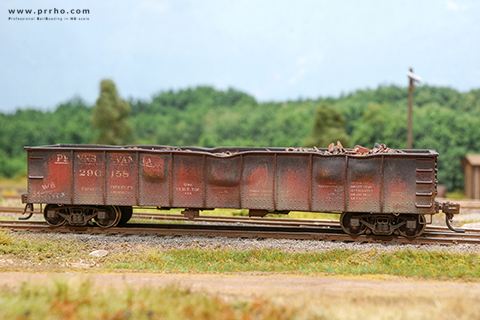 Funaro & Camerlengo GSD class gondola car. G31B class gondola car PRR #373149 (built 1951)  The G31 series was the first postwar gondola, introduced in November 1948. The class featured an interior length of 55.5 feet (16.7 m) and a fish-belly design. These cars lasted well beyond the Penn Central merger, with many still in service in the Conrail era. Subclasses ranged from A to N and included different manufacturers and sighting features. 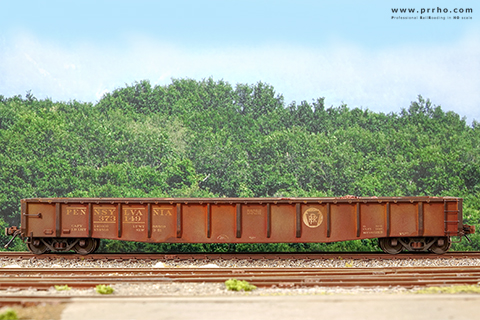 Tangent Scale Models G31b class gondola car. G43 class corrugated side gondola car PRR #387684 (built 1966) G43A sub-class corrugated side gondola car PC #576941 (built 1968) G43B sub-class corrugated side gondola car PC #564480 (built 1969) G43A sub-class corrugated side gondola car PC #576041 (built 1968)   The G43 gondola class was a 52-foot, 6-inch interior length corrugated-side gondola first saw production in 1966. Initially produced with a design based on "all panel corrugated", the following sub-classes later they had some changes. The variant G43b have no corrugations in the outward two panels, as well as DSI (Despatch Shops, Inc., Rochester NY) corrugated ends. The Pennsylvania Railroad and merger successor Penn Central built a total of 3.750 G43 class gondolas and its sub-classes G43A/G43B/G43C at the Sam Rea Shops in Hollidaysburg, PA, from 1966 to 1970.  Tangent Scale Models G43 class gondola car.  Tangent Scale Models G43 class gondola car. Bethlehem 70-Ton riveted drop-end LV #32904 (built 1950 repaint 1973) Bethlehem 70-Ton riveted drop-end LV #37076 (built 1952 repaint 1970)  This 52.6-foot (over 16-meter) long, 70-ton tipper gondola type was designed and manufactured by Bethlehem Steel for the first time in March 1937 on demand by the Baltimore & Ohio Railroad company. This car, referred to as the "O-59 class gondola car" for B&O, was built in over 4,000 units. Other railway companies bought these "Bethlehem" gondolas in the following years, until production ceased in 1957. They are used intensively, mostly by companies operating in highly industrialized eastern countries rich in foundries, for the transport of metal scrap and, not infrequently, coal and other natural materials such as crushed stone. Most of these gondolas were gradually withdrawn from service in the mid-1980s, replaced by more modern models. Tangent Scale Models Bethlehem gondola car. 65'6" Mill Gondola CR #593300 (built 1977)  First built by General American in the early 1940’s, the Mill gondola was designed for steel mill shipments that required extra length and versatility. The sturdy riveted construction could carry the necessary weight plus both end panels were hinged to fold inward. This allowed long beams and other extra-length loads to extend beyond the length of the car. When carrying such loads, the mill gondola requires flat cars coupled to both ends to allow clearance of the overhanging load. For Conrail was designated G33 class. 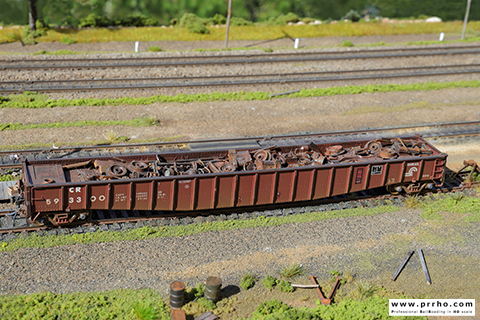 Athearn RTR Mill gondola car. REFRIGERATOR CAR Essentially a boxcar refrigerated, the reefer (refrigerator car) was designed to carry all perishable goods. The first refrigerator cars were being tested on the Northern Railroad in 1851, in New York. These cars featured some type of insulation and blocks of ice to keep the contents cool. The common merchandise carried were fruits, dairy, meat, and vegetables. Many railroads put in service huge quantities of reefer cars, at least until the beginning of the sixties. Following, the increase in traffic on the road caused a significant reduction in the use of rail transport of perishable goods, especially for short and medium distances. 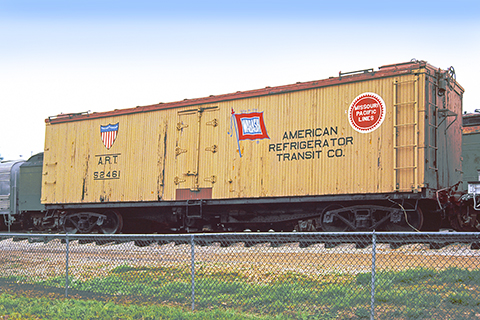 40' wood refrigerator car UP-WAB-MP A.R.T. #52461. 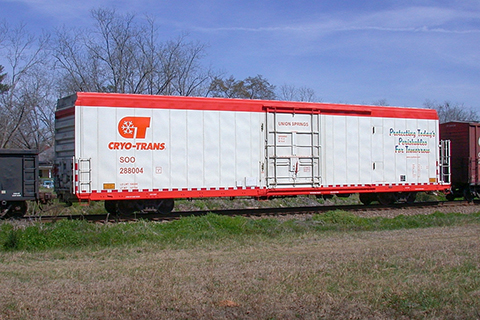 Cryogenic reefer car SOO Line #288004. 40' wood reefer BAR #6540 (built 1931)  Early “reefers” were of all wood construction and about 36’ long. The first 40 'model appeared from the end of the Second World War, built in wood but equipped with normal wood ends or new steel "dreadnaught" ends. As with box car development, steel components were incorporated into construction as technology improved. Stamped steel ends were added to the refrigerator cars to strengthen the body. “Double sheathing” remained a prominent part of the construction to insure maximum insulating properties. Equipped with steel roofs and Bettendorf trucks, these “reefers” could still be seen in trains during the 50’s.  Red Caboose wood refrigerator car. 40' wood-side refrigerator car MDI #17217 (built 1936)  Merchant Despatch Transportation Company (MDT) was a primary society to transit fresh perishable goods, with an enormous roster of refrigerator cars (at the height of its business, around 1940, it could count on almost 14 thousand cars). The wood-side types were used extensively until production was standardized on all-steel models.  Red Caboose wood refrigerator car. 40' insulated reefer FGEX #37363 (built 1954)  Fruit Growers Express (FGE) was a railroad refrigerator car leasing company. In 1919 the Federal Trade Commission forced the breakup of the Armour Refrigerator Line due to unfair competition. As a result, FGE was incorporated in Delaware on March 18, 1920, based out of Washington, D.C. to provide a shared reefer pool for the benefit of the ACL, B&O, PRR and Southern railroads. Additional railroads later joined: New Haven and N&W (1920), L&N and FEC (1923), C&O (1927), NYO&J (1931) and Pere Marquette (1940). In the 1950s FGE had a roster with over 12,000 refrigerator cars, including this all-metal type, the first built since 1940. The property of the series cars is of the Pennsylvania Railroad.  Intermountain Railway Co. 40-foot-long wood refrigerator car. | CABOOSE The caboose (cabin car for the Pennsylvania Railroad) was the last car in the consist about freight trains, used by conductors and other railroad workers for checking and to assist when needed, by ensuring the proper trip of the train, in complete safety. Cabooses were used on every freight train until the 1980s, when safety laws requiring the presence of cabooses and full crews were relaxed. Each north american railroad company has had in service their own types of caboose, but in more recent times, many companies have removed from service this rail transport vehicle, following the changing of the american rail transportation rules. Now, cabooses are generally only used on rail maintenance or hazardous materials trains, or on heritage and tourist railroads. In the U.S.A. surviving many units in service on short regional lines and industrial area or stored in museums. The classification of the caboose has been different from company to company, while the producers, identified the vehicles by their appearance and design adopted. Essentially, there are two concepts of development for the production of caboose, with or without the dome (cupola). The variants derived sort the subclasses and the common types were: built with wood or metal body, with centered or offset cupola, designed as transfert role, set with bay-windows (no cupola) or wide-vision's windows configuration. Almost all caboose products, were equipped with four-axle trucks (of different producers), but the american railroad pioneers had also supplied caboose with two axles, as types called "bobber caboose".  N7 class cabin car Conrail #21736 special services.  NE-6 class caboose Penn Central #23805. N5G class caboose CR #18693 (built 1944 -repaint 1977)  Among many types of caboose built for North American railroads throughout its history, the so-called Northeastern Design was one of the major types built in huge numbers, divided into classes based on the classification created by the user companies. Originally designed by the Reading Company in the early 1920, it was based on USRA prototype car, built using a sheathing wood (285 units were built). The caboose N5G class was a development of original RDG design. The production began in the mid-1930s for many railroads based in the East of the USA, as Lehigh Valley, Central Railroad of New Jersey, Western Maryland and others. 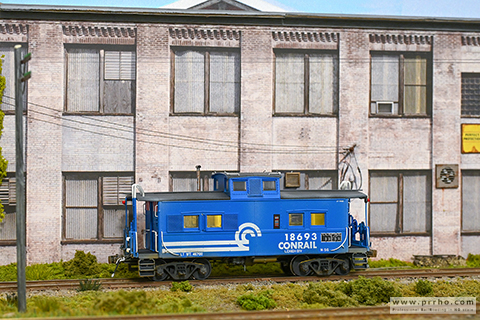 Rapido Trains N5G caboose. N6B class cabin car PRR #981693 (built 1910) N6B class cabin car PRR #  The cabin car N6b class of PRR was the most famous caboose put in service by railroad, used in hundreds units on the huge network of the "standard railroad of the world". Most cars rebuilt from 4 wheel wood underframe classes. There were Lines West (of Pittsburgh) cabins rebuilt in Lines West shops, starting 1914. These Lines West rebuilds into class N6a and N6b were concurrent with Altoona production of the N5 all-steel cabins for Lines East. Cupola placement could be variable: some rebuilds extended the body on only one end leaving the cupola near the other end, whereas others extended both ends leaving the cupola in the middle. N6b has narrower cupola with sloping sides. 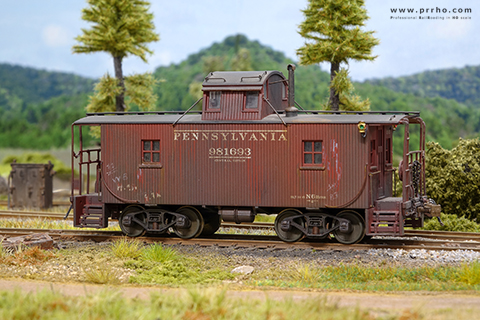 Walthers Proto PRR N6b class wood cabin car. N-7 class caboose CR-21522 (built 1949 - Repaint 1968 - Patched 1976)   The N-7 class cabins were designed by some American manufacturers for important Eastern railway companies in the late 1940s, exactly in 1948 when the first examples were produced for the New York Central company. Despatch Shops Incorporated (DSI) and St. Louis Car Company (SLCC) were the two most notable companies that began producing this type of "steel caboose" since the end of World War II. The Class N-7s were "wide vision/bay windows" cabooses, used in large numbers especially by the Penn Central company, inherited from the previous Pennsylvania Railroad and New York Central. Many examples were then inherited by the nascent Conrail, both as the original N7 and N7A, N7B, N7C, N7D and N7E variants. 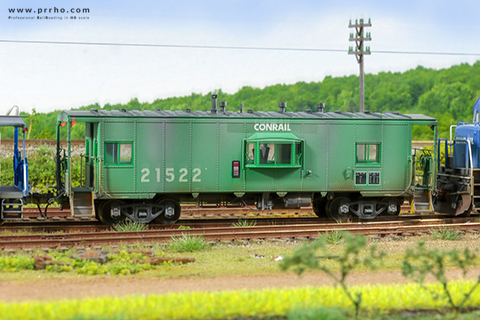 Tangent Scale Model N7 class caboose. NE-6 class caboose PC-19825 (built 1948 - re-built 1968)  The "all steel" NE-6 class of caboose originated in 1947-1948, built by Railway Equipment Company (as C635-709 production lot) purchased by the New York, New Haven & Hartford Railroad as NE-5 series. When New Haven merged to Penn Central contributed with some group of NE-6 (and some NE-5 class) renumbered with 19000 and 23000 series and were not modified when Conrail absorbed the Penn Central in 1976 (PC caboose numbers remained the same during the Conrail years). 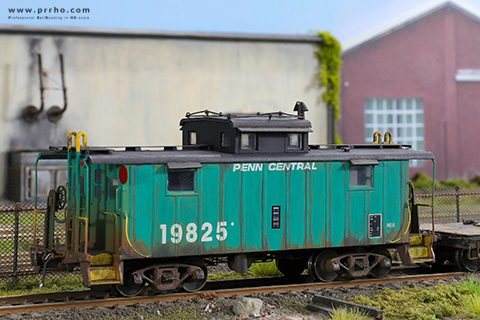 Centralia Car Shop NE6 class caboose. COVERED HOPPER Covered hoppers are very special freight cars common to many North American railway companies, built in very large numbers. Utilized to transport dense and heavy granular products like cement, clay, potash, and sand. In the United States, the leading manufacturer of covered hopper wagons is the Pullman-Standard Car Manufacturing (Pullman Company). The variant 4000 cubic foot PS-2 CD indoor hopper was manufactured by P.S. (first type developed) between 1962 and 1964 in the Butler's, PA, shops. These cars had a very long useful life, with some remaining in income service in the United States, Canada and Mexico until the early 2000s. One of the most distinctive Pullman-Standard covered hoppers, this common 90/100-ton car it was mainly used for cereals, malt, fertilizers and similar services. 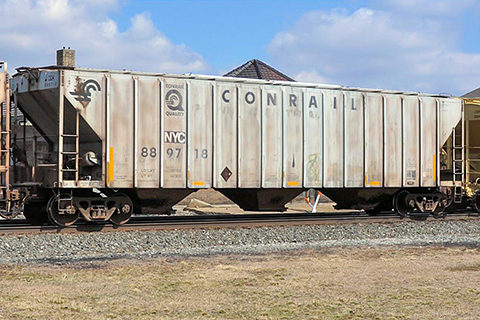 H54 class covered hopper Conrail-NYC #889718.  H51 class covered hopper Conrail #887094. H51 class Samuel Rea Shops 4600 Covered Hopper PC #887039 (built 1968) H51 class Samuel Rea Shops 4600 Covered Hopper LV #50964 (built 1968)   During the 1960s, railcar builders experimented with new covered hopper designs to satisfy the evolving needs of shippers as they moved away from forty-foot box cars to bulk transport railcars. Inspired by the success of the General American Transportation Corporation (GATC) 4500/4700 cubic foot covered hopper designs, the PC Samuel Rea Shops (SRS) designed and built clones of 4600 cubic foot capacity between 1968 and 1969. While these cars were externally very similar to GATC designs, SRS designed their 4600 with a slightly taller carbody and a longer car length. Penn Central outfitted the fleet with a variety of appliance options so the cars could be utilized in multiple services. PC’s own marketing department promoted the cars as “connecting the great grain producing regions to leading eastern ports and markets.” PC classed them in four total subclasses: H51, H51A, H51B, and H51C, for a total of 761 copies. Additionally, 100 cars were built for Lehigh Valley, majority-owned by PC. After serving into the Conrail and post-CR eras, some were sold to lessors. 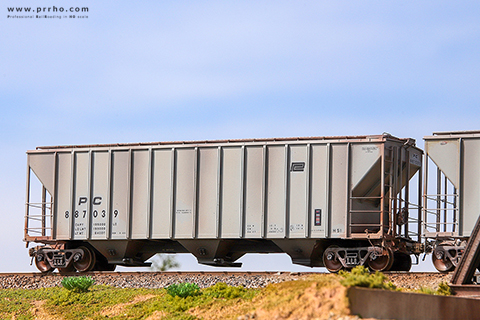 Tangent Scale Models H51 class SRS covered hopper. 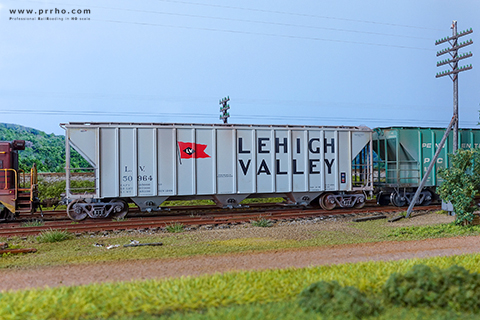 Tangent Scale Models H51 class SRS covered hopper. H47a class Magor 4750 covered hopper PRR #260684 (built 1965)  The Magor Car Corporation was a New Jersey-based car builder, who from the early 1900s, concentrated on the manufacture of freight cars for international export. However, in 1963, the company was encouraged to give new consideration to the domestic market, based in part upon the success of Magor's aluminum designed freight cars. Previously, Magor had cooperated with Reynolds Materials and the Southern Railway to mass produce the first aluminum freight car for the U.S. market. In 1965, Magor introduced the 4750 cubic capacity aluminum covered hopper. Marketed as a car whose light tare meant more payload capacity, the Magor 4750 Covered Hopper which proved to be one of its most successful aluminum-based designs. For the Pennsylvania Railroad these types of covered hoppers with 3-bay were designated the H47 class (and sub-classe such as H47a). 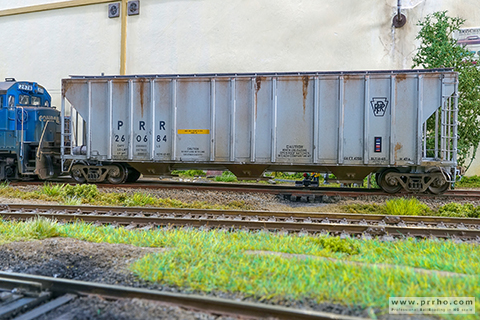 Exactrail Magor 4750 covered hopper. H30 class 3-bay covered hopper PC #32349 "sand service" (built 1936 PRR, rebuilt 1969 PC)  The Pennsylvania Railroad started building 70-ton H30 class covered hoppers around 1935. During the Sixty years, the capacity of the remaining cars was increased to 77tons from 70tons. At the time of merging between the Pennsylvania Railroad and the New York Central Railroad, with the creation of the Penn Central company, remained in service around 1.000 exemplaries of H30. Many "sand service" H30 covered hoppers were used on the first years of Conrail era. 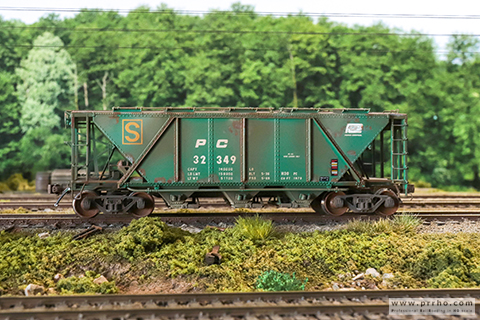 Bowser H30 class covered hopper. H34a class 2-bay covered hopper PRR #257156 (built 1955)  The H34s were a series of 70-ton, two-bay covered hopper cars. After copying an ACF two-bay design for the H33s, the PRR decided to contract Pullam-Standard to build 300 cars of their version of the two-bay covered hopper, the PS-2, in April 1954. Following the initial success of the design, the PRR built them themselves or had additional lots built by Pullman-Standard through 1958, bringing the fleet to 1,900 cars. Several design changes during production included redistributing the roof hatches, adding side stairs, and changing the top-ties from channels to U-ribs. All of these types were widely used throughout the system until the Penn Central was formed, and some of these remained in this design until Conrail. The sub-class H34As were built by the Altoona Works, using parts supplied by Pullman Standard, between May and June 1955. 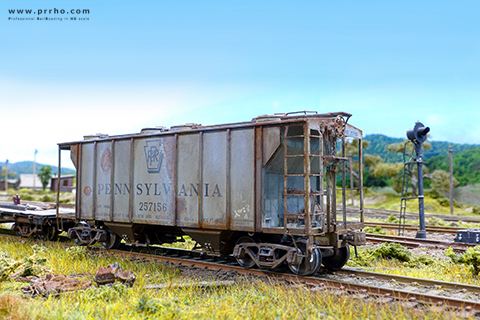 Kadee H34a class 2-bay covered hopper. PS-2 4427 "High Side" Covered Hopper EJ&E-RI restencil #131016 (built 1974)   Developed from "low-side" variant, the series 4427 “High Side” production ended in 1971 after delivery of approximately 12,000 cars. Built by Pullman-Standard in some thousands units, these covered-hopper cars met the needs of rail freight shippers for bulk transport. 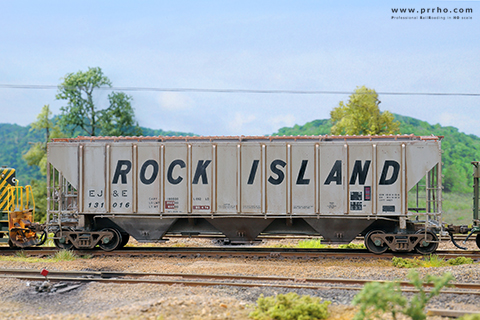 Tangent Scale Models PS-2 4427 covered hopper. PS-2CD 4785 covered hopper PC #890043 (built 1972) PS-2CD 4785 covered hopper PC #886836 (built 1967) PS-2CD 4785 covered hopper PC #886924 (built 1975)  The PS-2CD 4785 Covered Hopper was a missing variation in the Pullman-Standard Covered Hopper family until now. The 4785s low side sill visually differentiates the carbody from its high sill siblings (4727, 4740, and 4750). Since the 1960s, these cars have crisscrossed North America in singles and groups of hoppers. One of the larger sizes offered in the Pullman-Standard covered hopper catalog, the PS-2CD 4785 cubic foot design could be optimized for a variety of commodities, from grain products, to chemical or mineral ladings. Introduced in 1967 and built at their Butler, PA plant, the basic design would see refinements to its basic design over its five-year production span. 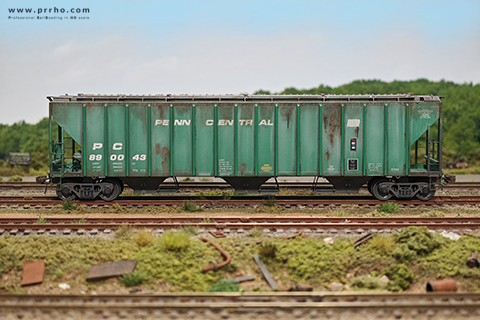 Scale Trains R.C. PS-2 covered hopper. 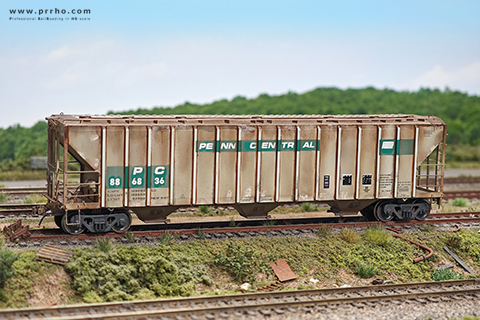 Intermountain Railway Co. PS-2 covered hopper. 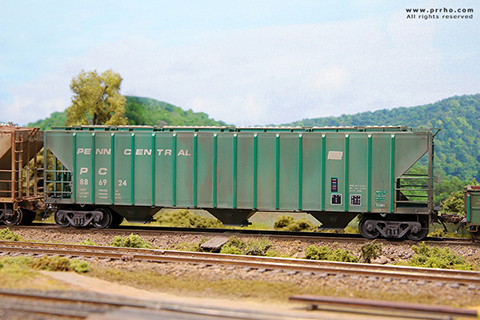 Intermountain Railway Co. PS-2 covered hopper. FLATCAR Since the beginning of the American railroad the flatcar have been used to transport nearly all bulk products, including machinery, pipes, pulp, and lumber. Used for general services, the deck has been built entirely of steel since the early 1900s. The USRA (United States Railroad Administration) designed a 55 ton / 42 foot flat car and some 8,000 cars were built. Many other variations followed; for example, 50 tons / 46 feet and 70 tons / 53 feet, built by AAR (Association of Railroads) and Pullman-Standard between 1940-1950. Other types of flatcars were those adapted for the transport of trailers and containers (piggyback trains). 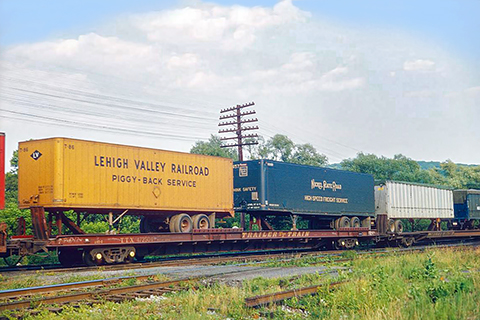 Trailer Train TOFC flatcar TTX #472504.  Flatcar 693F Penn Central #715453. F30A PRR class flatcar PC #701550-#702058 (built 1934 - re-built 1973) F30D PRR class TOFC flatcar TTX #475064 (built 1962)   The Pennsylvania Railroad's class F30A flatcars were one of the largest classes of this type of freight car for the railroad, with 1,500 built between 1933 and 1934. The PRR used a massive one-piece steel casting for these cars (long 40 foot, around 12 meters) and this construction provided an incredibly long life for many of these cars. The F30s were a huge success and the PRR built another 250 nearly identical cars in 1951, designated F30Ds. Beginning in 1954, the Pennsy converted many F30D flat cars into the first service "piggyback" cars (TOFC - Trailer On Flat Car). These cars received perforated sidewalls, end loading ramps, and four side posts. 84 units were transferred to the new Trailer Train Company (TTX, founded by the PRR along with Norfolk & Western) between 1957 and 1958. These cars received further upgrades in the form of ACF couplings, revised sidewalls and improved end ramps. The TTX flatcars also received conversions to roller bearings on their trucks and were designated F30G, used by TTX until the 1980s and painted in the TTX yellow livery typical for rubber rolling stock. 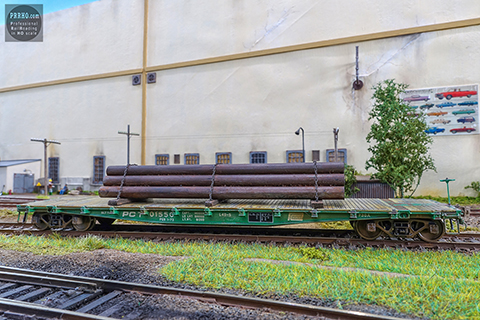 Rapido Trains F30A general purpose flatcar. 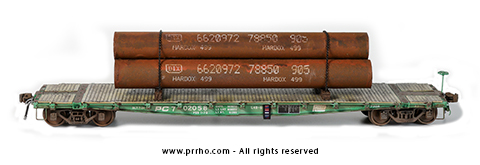 Rapido Trains F30A general purpose flatcar. 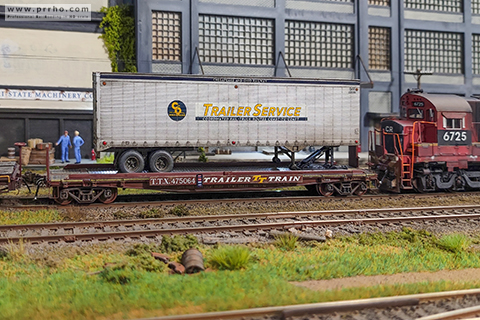 Rapido Trains F30D TOFC flatcar. F60-GH class 60' trailer train flatcar HTTX #91534 (built 1968) F60-GH class 60' trailer train flatcar HTTX #93226 (built 1968)  TTX Company (formerly TrailerTrain and founded by Pennsylvania Railroad and Norfolk & Western Railway) a provider of railcars and its "trailer flat cars" are the main option for many railroads about "piggybacking" train services. From 1956 over 165.000 cars (flatcars, boxcars and gondolas) were built and leased at the major american railroads. Between 1964-1975, TrailerTrain (now known as TTX Co.) acquired a fleet of 5.000 modern 60' flats built by ACF, Thrall and Pullman Standard. TTX cars were assigned to various classes to handle loads as auto frames, logs, military vehicles, farm equipment and construction equipment. Some were even modified to handle TTX's bread and butter, intermodal containers. 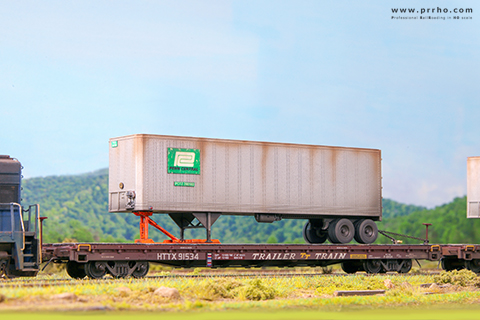 Intermountain Railway Co. F60-GH flatcar (with trailer). F89-F TFOC flatcar TTX-154869 (built 1965)  Introduced in the early 1960s, the Trailer Train (now TTX Company) F89-F flat car has been a mainstay of contemporary railroading, designed to carry 28', 40', 45', 48' and 53' trailers in TOFC (Trailer On Flat Car) consist. Produced by the Bethlehem Steel Company (BSC) plant in Johnstown, Pennsylvania, over 9.000 units were built during beetwen 1962 and 1978. Updated versions, from 1980 produced in a yellow livery with variants suitable for hauling any road and non-road machinery, remain in service throughout the entire U.S. rail network. 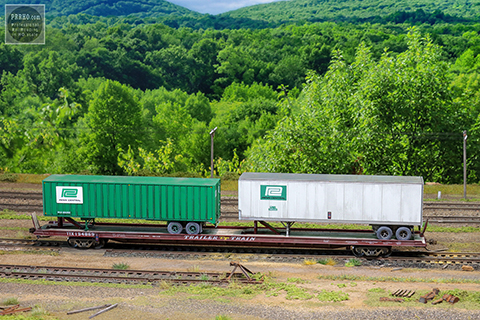 Athearn Genesis F89-F TFOC flatcar (with trailers). OPEN HOPPER The open hopper car is a main actor of railroading history. Coal is undoubtedly one of the most important goods transported by trains since the dawn of rail transport. The first "open hoppers" used, called "jimmies" by the railway pioneers, were essentially a little two-axle cars used on mule-powered railroads of the 1820's and 1830's to haul about 1.5 tons of coal (3,000 pounds) from mines to a nearby canal or river. The little jimmies carried the basic features of the modern hopper that differentiates it from the gondola. However, the early hoppers were essentially an extravagant version of a gondola car. The first original hoppers with unloading of coal through a doublel-bay system, appeared in the mid of XIX century. With the new century, thanks mainly to the change from wood to iron/steel in the construction of rail cars, were built models with capacity up to 55 tons, which were the standard until the advent of the 4-bay hopper car with greater length and increased load from 70 to 100 tons. 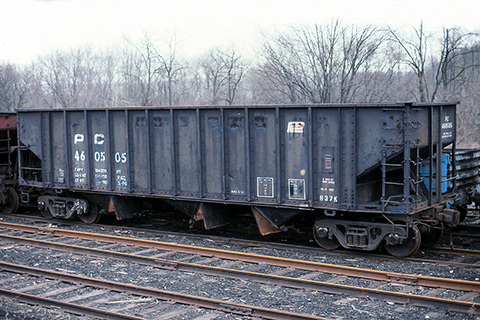 H37K class open hopper Penn Central #460505 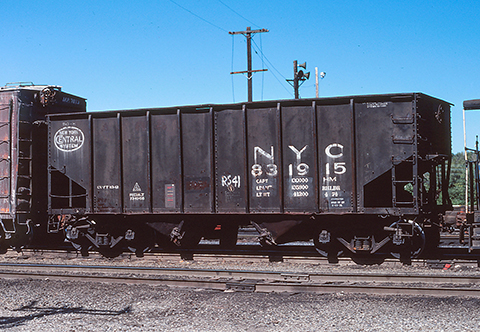 Two-bay open hopper New York Central #831915. 55-ton GLA class USRA two-bay hopper car PRR #220149-#220158 (built 1919)  Over 22.000 units of this hopper car were delivered by the U.S.R.A. to 23 railroads. This familiar car is the most long lived and successful USRA design. Many were in still service into the "sixties" and some even into the "seventies". 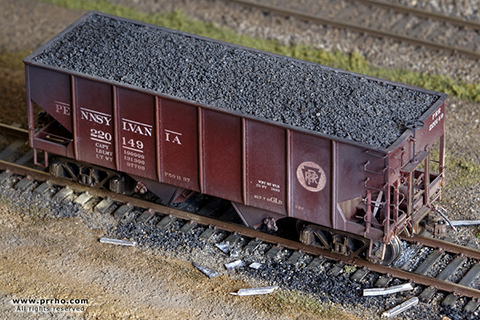 M.T.H. GLA class 2-bay hopper car. 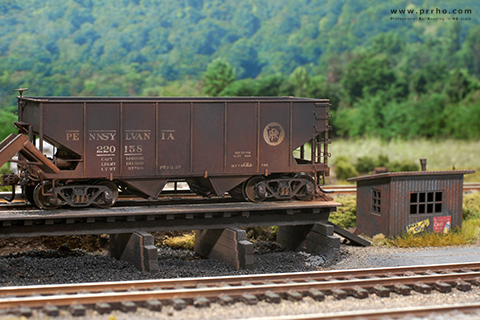 M.T.H. GLA class 2-bay hopper car. 50-Ton AAR Standard two-bay open hopper car NYC #867336 (built 1945)  The design of the AAR Standard 2-Bay hopper dates to 1935. Cars were manufactured up to 1949. The car is an open top, self clearing design , AAR class HM, including off-set sides, and has 50 ton capacity. 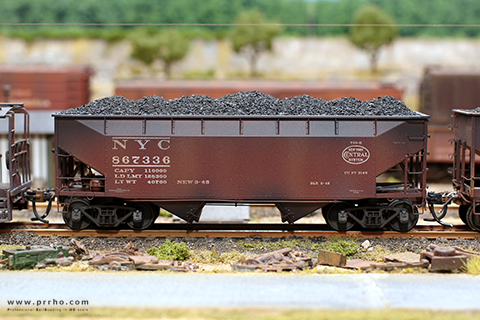 Kadee AAR Standard two-bay hopper. 70-ton H21a class 4-bay open coal car PRR #135500 (built 1915) 70-ton H21a class 4-bay open coal car PRR #197319 (built 1916) 70-ton H21a class 4-bay open coal car PRR #177060 (built 1916) In 1911 thru 1917, the 70ton H21 "quad" hoppers were introduced for coal and coke services, by PRR and others railroads. During 1922 and 1923, all early H21 hoppers were converted to H21a's by replacing the 50ton trucks with 70ton trucks, equipping them for coal service and bringing the total to 36.000 H21a hopper cars. Pennsylvania Railroad classified its H21a class open hopper through many sub-classes, based on aesthetic and functional differences (early scheme, circle logo, keystone logo etc.). This 70-ton coal-carrying subclass were fitted with Crown trucks. A total of 14.270 units were built new between August 1915 and July 1918, or acquired second-hand later. In addition to Altoona Shops, cars were built by Pressed Steel Car Company, Cambria Steel Company, American Car & Foundry, Standard Steel Car Company and Ralston Steel Car Company. Other H21a's were converted from H21, H22, and H22A cars. The total fleet of H21a reached its maximum of 39.123 in July 1947. 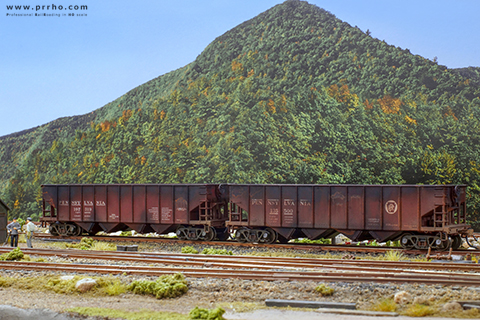 Bowser Executive RTR H21a class 4-bay hopper cars. 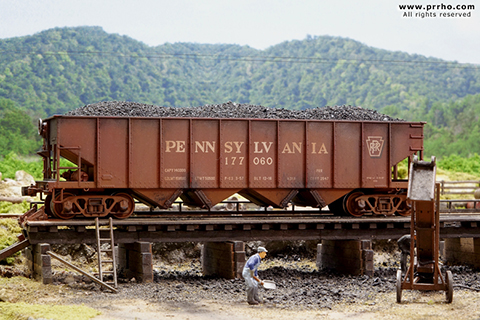 Bowser Executive RTR H21a class 4-bay hopper car. 70-ton H37G class 3-bay hopper car PC #459788/PC #459801 (built 1971)  An evolution of the early 70-ton capacity open hopper cars that appeared in the mid-1930s, the 3-bay H37 class series was produced for the Pennsylvania Railroad and designed specifically to transport bituminous coal to large industrial customers and railroads, in long specialized trains of several dozen cars. In contrast, cleaner-burning anthracite coal, most commonly shipped to small local coal dealers serving the home heating market, often traveled in smaller 2-bay hoppers. 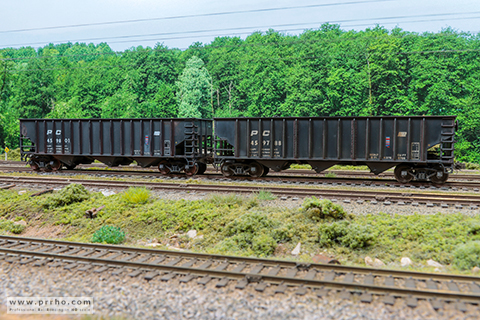 Bowser Executive RTR 70-ton 3-bay open hopper. 70-ton Pullman-Standard PS-3 2750 open hopper car LN #75242  In the 1950s, Pullman-Standard began developing a “standardized” line of boxcars, marketed in “families.” Beginning with the PS-1 boxcars and PS-2 covered hoppers, the PS-3 open hopper was launched with several offerings, the most prolific of which was this 70-ton, 3-bay coal hopper with a capacity of 2,750 cubic feet. First purchased in 1957, Pullman-Standard not only launched an effective marketing message with the “PS” series, but also developed simultaneous production capacity at its Bessemer (Alabama) and Butler (Pennsylvania) plants, ensuring customers a quick response to the many requests for medium and large capacity coal hoppers. Among the largest purchasers of the PS-3 open coal hoppers was the Louisville and Nashville company (The Dixie Line), which selected the 2- and 3-place hoppers manufactured by Pullman-Standard as the standard for their coal-delivery fleet prior to the 1970s, purchasing several thousand units. 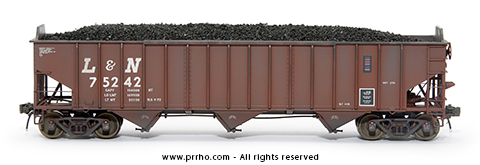 Tangent Scale Models PS-3 2750 open coal hopper. 100-ton Pullman-Standar 3526/3600 open hopper car B&O #197571 (built 1975) 100-ton Pullman-Standar 3526/3600 open hopper car SOU #78873/#78904 (built 1975)  Pullman-Standard was one of several manufacturers of new open coal hopper models produced in 1975-1976 to meet this urgent demand for modern 100-ton capacity "triple" cars. While western and midwestern customers purchased the 4.000 cu ft. PS models, eastern railroads purchased the 3.526/3.600 cu ft. PS variants, which actually had shorter sides to accommodate higher density coal. Chessie/B&O, Chessie/WM and Southern each purchased the PS-3526/3600 HT coal cars for use with eastern carriers. The design and appearance of the PS-3526/3600 HT models are identical to the PS-4000 HT model, including the originals "trapezoid" indentations in the sides of the cars. However, they have lower sides than the PS-4000 HT. 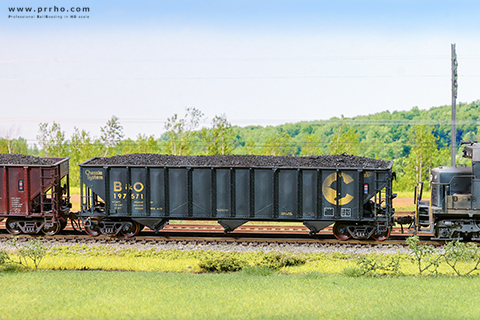 Tangent Scale Models PS-3526/3600 coal open hopper.  Tangent Scale Models PS-3526/3600 open hopper. 100-ton Bethlehem 3737 open coal hopper car TP-MP #588061 (built 1974)   With over 10,000 units produced, this is one of the most productive steel coal hoppers of the last 40 years, primarily in the western United States. The first delivery of Bethlehem 3737/3716 was made to Chicago & Eastern Illinois in 1973, with subsequent orders going to Texas & Pacific, Missouri Pacific, Chicago & North Western and several utility companies, such as Indianapolis Power and Light. Many of these hoppers are still in service in recent years, with many having been converted to 12,000-cubic-foot capacity rail cars. 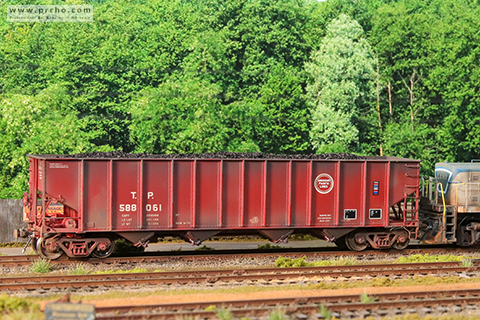 Exactrail Bethlehem 3737 open hopper. TANK CAR The history of tank cars dates back over 150 years. They are used to transport various liquids and gases, and their cargoes include petroleum products, chemicals, and food products. Tank cars can be pressurized or unpressurized, insulated or uninsulated, and, depending on the type, can be used for multiple types of freight or reserved for a specific type. A large percentage of tank cars in use throughout the North American rail network are usually owned by freight forwarders or leasing companies, rather than the railroads. This can be verified by examining the identification marks on the cars. These marks invariably end in an X, indicating that the owner is not a common carrier. Today, tens of thousands of tank cars are in service on North American railroads.  General American 11.000 gallons tank car ACFX #6866. 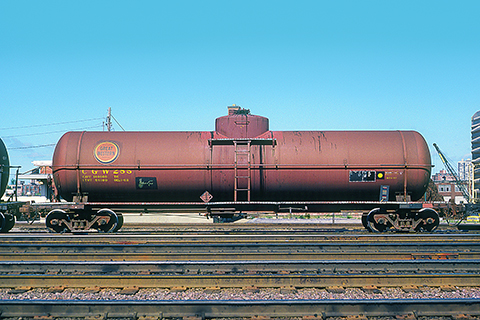 CSI AAR 20.000 gallons tank car Chicago Great Western #285. 20.000 gallons Procor GP20 tank car NCTX #23025 (built 1973)  Founded in 1952, Products Tank Line (renamed Procor in 1962) built its own manufacturing plant in the mid-1950s in Oakville, Ontario. Initially, the design was provided by parent company Union Tank Car Company. In the 1960s, Procor produced tank cars based on modern standards and the GP20 model was suitable for lower density commodities that would not freeze or freeze at low temperatures, such as various oils and fuel. It was produced from 1969 to 1984 in almost 1,000 units and was available in 70- and 100-ton truck capacities. These types of tank cars are in use throughout North America for both fleet service and for rental to numerous companies. Common identification marks for these cars included UTLX (Union Tank Car), PROX (Procor), NCTX (North American Car Co.), BCOL (British Columbia Railway), and CN (Canadian National).  Rapido Trains GP20 Procor 20.000 gallons tank car. |








